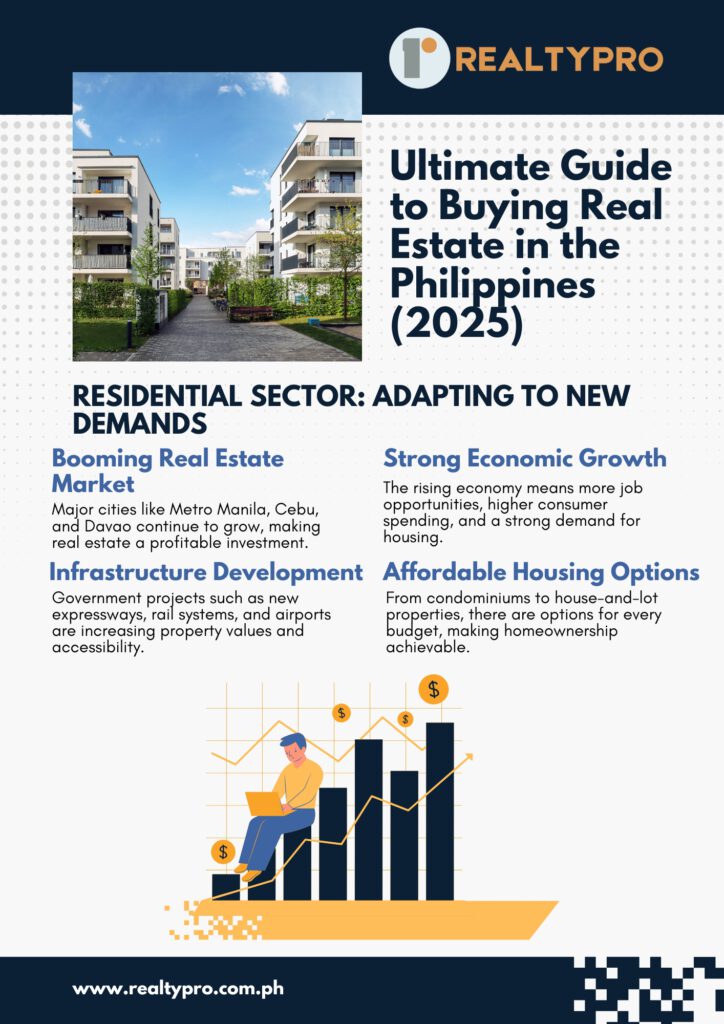The Philippine real estate market in 2025 not only presents exciting opportunities for both local and foreign buyers but also offers a thriving investment landscape. Furthermore, with continuous infrastructure developments, stable economic growth, and evolving property trends, now is an excellent time to invest. Whether you’re a first-time homebuyer, a seasoned investor, or an OFW planning to purchase property, this guide will help you navigate the process step by step while ensuring you make well-informed decisions.
Why Invest in Real Estate in the Philippines?
1. A Growing and Profitable Market
To begin with, key cities like Metro Manila, Cebu, and Davao are expanding rapidly. Moreover, as urbanization increases, the demand for housing continues to rise, leading to strong property appreciation over time. Therefore, investing early allows buyers to maximize potential returns before prices climb higher.
2. Expanding Infrastructure
In addition to the booming property market, the government’s major infrastructure projects—including expressways, railways, and airports—are enhancing accessibility and connectivity. Consequently, these improvements drive property values upward, making investments in strategic locations even more lucrative.
3. A Strong and Stable Economy
Not only is the Philippine economy steadily growing, but it is also creating more job opportunities, which in turn leads to higher consumer spending. As a result, real estate remains a highly attractive asset for both local and foreign investors looking for stable, long-term gains.
4. Affordable Housing Options
Unlike other countries where housing prices may be too high, the Philippines offers a wide range of real estate options. From budget-friendly condominiums to house-and-lot properties, buyers can choose according to their financial capability. Additionally, flexible financing programs allow more people to achieve homeownership without the need for large upfront costs.
Step-by-Step Guide to Buying Property in the Philippines
1. Set Your Budget and Explore Financing Options
- First and foremost, assess your financial capacity to determine how much you can afford.
- Next, consider housing loan options from banks or the Pag-IBIG Fund, as they offer competitive interest rates.
- Additionally, if you’re interested in pre-selling properties, developer financing provides a flexible way to secure a home at a lower price.
2. Choose the Right Location
- Metro Manila – Best for professionals seeking career opportunities, accessibility, and modern city life.
- Cebu & Davao – Ideal for business investments and retirement, given their economic growth and relaxed lifestyle.
- Laguna, Cavite & Pampanga – These emerging areas offer lower property prices while still promising strong appreciation potential.
3. Pick the Right Type of Property
- If you prefer a lower price with flexible payment terms, pre-selling units may be a great option. Conversely, ready-for-occupancy (RFO) properties are better suited for those who need an immediate move-in.
- Condominiums are excellent for those seeking urban convenience, while house-and-lot properties offer more space and long-term value.
- Commercial properties, on the other hand, can generate high rental income, making them ideal for business owners.
4. Work with Licensed Real Estate Professionals
- To avoid scams, it is highly recommended to work only with licensed brokers and agents.
- Moreover, verifying the property’s legitimacy through the Land Registration Authority (LRA) ensures that you’re making a safe and legal purchase.
5. Check Legal Documents and Ownership
- Before finalizing any deal, make sure to confirm ownership using the Torrens Title System.
- Furthermore, securing a Tax Declaration Certificate will help avoid legal disputes in the future.
- Reviewing the Deed of Sale and Contract to Sell is also crucial, as it guarantees that all terms and conditions are clearly defined.
6. Pay the Required Fees and Taxes
When purchasing real estate, you will need to cover:
- Documentary Stamp Tax – 1.5% of the selling price
- Transfer Tax – 0.5%–0.75% (depending on location)
- Registration Fees and Notarial Fees
Since these fees can vary, it is important to budget accordingly to avoid any unexpected expenses.
7. Transfer Ownership
- Once all payments are settled, securing a Transfer Certificate of Title (TCT) or a Condominium Certificate of Title (CCT) is the final step to officially establish ownership.
- Additionally, buyers must process tax payments at the Bureau of Internal Revenue (BIR) and register the property with the Registry of Deeds.
- Doing so ensures that your real estate transaction is legally recorded and protected.
Can Foreigners Buy Property in the Philippines?
Yes, but there are several legal restrictions. Here are some ways foreigners can invest in Philippine real estate:
✅ Condominium Ownership – Foreigners can legally own condominium units, provided that foreign ownership does not exceed 40% of the total building units.
✅ Land Ownership via a Corporation – If you form a corporation where at least 60% of the ownership is Filipino, the corporation can legally purchase land.
✅ Long-Term Lease Agreements – Foreigners can lease land for up to 50 years, with the option to renew for another 25 years.
Final Thoughts
Buying real estate in the Philippines in 2025 is not only a smart financial move but also an exciting opportunity to invest in a growing market. By choosing the right location, working with professionals, and understanding the legal requirements, you can make a secure and profitable investment.
Now that you have all the essential information, it’s time to take action—start your real estate journey today and turn your dream investment into reality! 🏡✨


